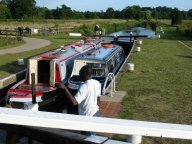Arundel
Eighteen miles west of Brighton, the medieval hilltop town of Arundel overlooks the Valley of the River Arun.
Arundel was bequeathed by King Alfred to his nephew in 901. By the time of the Domesday Book, it was a thriving port.
The main features of the town are its castle and cathedral.
Arundel Castle towers over the town. Dating from Norman times, its imposing medieval appearance is misleading as even though it dates from Norman times, it is only around a century old. The castle was destroyed in the English Civil War, then rebuilt from 1718 onwards by the eighth, eleventh and fifteenth Dukes of Norfolk. The castle has been the seat of the Dukes of Norfolk for seven centuries. Two of the nieces of the Third Duke, Anne Boleyn and Catherine Howard, were wives of Henry VIII.
The Gothic Arundel Cathedral was constructed in the 1870s by the fifteenth Duke of Norfolk on the site of the town's Catholic church. The cathedral's spire was designed by John Hansom, best known as the inventor of the Hanson Cab, the world's first taxi. Arundel Cathedral was not designated a cathedral until the foundation of the Diocese of Arundel and Brighton in 1965. It now serves as the seat of the Bishop of Arundel and Brighton.
Author and artist Mervyn Peake lived in Burpham near Arundel. Philosopher and broadcaster C E M Joad wrote many of his books at South Stoke Farm near Arundel.
Boats for hire are available on the River Arun. The River Arun is Sussex's largest river. It rises in St Leonard's Forest near Horsham, near Pulham it receives the Western Rother, passes through Arundel, then reaches the sea at Littlehampton.
From The Bridge, is what is claimed to be the best view of Arundel Castle. The ruins on the bank of the river by the bridge are the remains of the Maison Dieu, an almshouse founded in 1395 by Richard Fitzalan for twenty poor men.
 The River Arun was connected to the River Wey at Shalford near Guildford by the ill-fated and short-lived Wey & Arun Canal. Shortage of water meant the canal was never a success. The strategic importance of the canal cannot be overstated as it provided a route from London to the South Coast, boats could avoid going around the coast where they risked being attacked by the French.
The River Arun was connected to the River Wey at Shalford near Guildford by the ill-fated and short-lived Wey & Arun Canal. Shortage of water meant the canal was never a success. The strategic importance of the canal cannot be overstated as it provided a route from London to the South Coast, boats could avoid going around the coast where they risked being attacked by the French.
The Arundel Festival takes place in the last week of August.
Arundel Station is just across the river from the town, about half a mile from the town centre. Trains from London Victoria, Portsmouth, Brighton and Chichester.
Worth visiting outside of Arundel: Bignor Roman Villa with what is probably the best Roman mosaics in the country and the 17th century Petworth House with its impressive collection of paintings.
Six miles north of Arundel nestling in the foothills of the South Downs lies Bignor Roman Villa. It was first excavated in 1811, then 1819. It features Roman mosaics and the remains of a hypocaust, a Roman underfloor heating system.
The late 17th century Petworth House is adjacent to the pretty Sussex town of Petworth. It has an impressive collection of paintings including works by Turner (who was a frequent guest at the house), Van Dyck, Titian, Gainsborough, Bosch, Reynolds and Blake.
In Petworth High Street, how the other half lived can be seen by visiting Petworth Cottage Museum, the home of a former employee of Petworth House.
Petworth Cottage Museum is an old cottage, restored to how it was in 1910 using the possessions of its former occupant Seamstress Mary Cummings. It is open winter weekends to enable visitors to expereince a gas-lit cottage.
Petworth is an old-world town with narrow irregular streets.
Another popular excursion from Arundel is to Amberley, regarded as the quintessential English village. Amberley Castle dating from the 14th century was once the residence of the Bishop of Chichester.
The nearby town of Chichester is also worth visiting.
Sussex
(c)
Keith Parkins 2006 --
September 2006 rev 1
 The River Arun was connected to the River Wey at Shalford near Guildford by the ill-fated and short-lived Wey & Arun Canal. Shortage of water meant the canal was never a success. The strategic importance of the canal cannot be overstated as it provided a route from London to the South Coast, boats could avoid going around the coast where they risked being attacked by the French.
The River Arun was connected to the River Wey at Shalford near Guildford by the ill-fated and short-lived Wey & Arun Canal. Shortage of water meant the canal was never a success. The strategic importance of the canal cannot be overstated as it provided a route from London to the South Coast, boats could avoid going around the coast where they risked being attacked by the French.